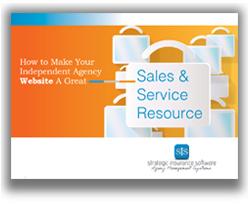Marketing, Technology Trends
 There was a time when websites were viewed from a computer connected to a land-line, and only when phone lines were free. Today, your agency’s website can be accessed almost anywhere, at any time, and on multiple devices. From smartphones, to tablets, and to everything in between—your site must be compatible.
There was a time when websites were viewed from a computer connected to a land-line, and only when phone lines were free. Today, your agency’s website can be accessed almost anywhere, at any time, and on multiple devices. From smartphones, to tablets, and to everything in between—your site must be compatible.
It’s a mistake to think that a website displayed on a laptop will look the same on a mobile device. Your agency’s website needs to change depending on the device used to view it. This is called having a responsive website: a site that molds itself to fit how it’s viewed.
What it means
A responsive website adapts to the screen used to view it. This means the layout of a site will modify itself depending on the screen size—including changing the orientation and making menus/navigation accessible in different ways. This isn’t the same as building a mobile website: the big difference here is that it’s all one site, with multiple layout options.
Making your website responsive is easy for developers as it simply requires creating a different style sheet for each page. No change in information or content, just tweaks in how it’s displayed.
Why it’s important
A 2014 Hubspot article touched on a few of the reasons why your agency needs a responsive website. According to Hubspot, 25% of all internet users go online using a mobile device and more than 20% of Google searches were done via mobile. This is a large chunk of users you’re missing out on without a responsive website. In addition, Google penalizes non-responsive sites in its search algorithm. That alone is incentive to update.
Being responsive also means your agency’s website will be ready for future devices. Ten years ago, you didn’t know you’d need to be ready for smartphones – who knows what will be coming next? By creating a responsive design you can simply add-on a new layout to adapt to the latest technology.
Get on board!
If you don’t have a responsive web design, you’re due to get up with the times. Contact your web developer to get the process started, or if you’re hosting in-house, get your web team on the case. There are multiple online tutorials and sample layouts to get started.
SIS is keeping up
Here at SIS we know and are responding (pun intended) to responsive web design, which is why we moved our Partner XE to be mobile-accessible. Our latest Partner XE 2015 has even more added features to improve your agency’s workflow efficiency. Find out more by visiting our website or contact us at [email protected].
Marketing, Technology Trends
 As we explored in our last post, website technology and design have continued to evolve and advance over the years. No longer are a few photos and links enough for even an average site – users are now looking for a more innovative design to prove a business’ legitimacy. Just as holding a flip phone is a mark of being behind the times, so is a website without smart phone-equivalent technology.
As we explored in our last post, website technology and design have continued to evolve and advance over the years. No longer are a few photos and links enough for even an average site – users are now looking for a more innovative design to prove a business’ legitimacy. Just as holding a flip phone is a mark of being behind the times, so is a website without smart phone-equivalent technology.
Yet, just as there seems to be a new version of the iPhone each year, it can be hard to keep up with advances in website design. It is especially difficult to separate passing fads from lasting industry trends. To ensure your agency’s website is up to par and not over the top, we suggest focusing on these design aspects:
- 1. Acknowledging devices
If your agency’s website is not adapting for mobile devices, you are behind the curve. To add insult to injury, Google is now penalizing sites that are not mobile responsive. Most CSS website platforms now automatically offer mobile conversion, but if your website was made more than 5 years ago you may need to manually add a mobile version.
- 2. Using navigation widgets
The navigation menu is the most used and the most changed aspect of a website. Modern sites now use a variety of widgets to update navigation. One of the most popular is a “sticky navigation”, which stays glued to a section of the screen no matter where the user scrolls or navigates. Adding this to your agency’s website is easy, and will make it a much better experience for visitors who come to your website.
- 3. Thinking Outside the Box
No longer are text and image boxes the norm. Modern sites now look to other shapes, namely circles, to convey content. This doesn’t mean corners are out altogether. Irregular polygons and any other non-square shapes can easily bring your agency’s website to modern times.
- 4. Integrating Maps
You may have your agency’s location on your website, but do you have it on a map? Just this simple step of integrating maps, specifically Google Maps, to your site steps it up a notch. Google has made adding maps easy and web design sites such as WordPress have a simple drag and drop map integration. Don’t stop at just adding your agency’s location: add your partners, local supporters, and any other important locations in your area to spruce things up a bit.
Staying up to date and relevant is important not only for your agency’s website, but for all your technology choices. One of the most important tech pieces to stay updated is your agency management system.
We at SIS know the importance of keeping up with the best and most efficient management system practices, which we have put into our latest Partner XE 2015. This version of Partner XE promises a better user experience, enhanced functionality, and more efficient workflow. To find out more about the latest updates, contact us today at [email protected].
Marketing, Technology Trends
 You’ve put a lot of time and effort into your agency’s website, crafting a great sales and service tool for your customers, partners, and employees. It’s out there and it looks good, but your work is not done. To make your website great, you need regular maintenance and updates. Just as you constantly check in and update your customers, you must do the same with your website to stay relevant and competitive.
You’ve put a lot of time and effort into your agency’s website, crafting a great sales and service tool for your customers, partners, and employees. It’s out there and it looks good, but your work is not done. To make your website great, you need regular maintenance and updates. Just as you constantly check in and update your customers, you must do the same with your website to stay relevant and competitive.
The key to a quality site is a positive user experience. Your agency’s website must be intuitive, clean, and easy to navigate. Sometimes it can be hard to tell if it’s up to snuff, so look for signs that it’s time to update. You’re due for a re-vamp when:
Your site is NOT MOBILE READY
Mobile compatible websites are a must for any business. If your agency isn’t mobile ready, this should be your first order of business. Creating a mobile friendly website is easy and with platforms such as Squarespace, your site can go mobile with the click of a button. However, you should always preview and test first, working out any kinks before making it live.
Your site is STATIC
It’s okay to have some static elements of your website, but it should have dynamic aspects as well. Current CSS updates make it easy to add elements such as videos and social media feeds, making your page come alive to users. Look into responsive designs offering roll over and other interactive elements to keep users interested.
Your site has the ORIGINAL DESIGN
If it’s been over two years since you created your agency’s website, you’re overdue for a redesign. Trends change and your existing and potential customers will be looking for a site reflecting the current style. This means changing colors, menu navigations, and other aspects of page design. New technology quickly makes what was impossible yesterday, possible. Check out some recent design trends at 99designs.com.
Your site has OUTDATED INFORMATION
Part of making your website dynamic is keeping the information fresh. This means updating your agency’s address, phone, employee information, and including an aspect that is always changing. Include a blog, “tip of the day”, or customer testimonial to keep things current and relevant.
Check out other agency and industry sites to see how yours compares. By taking a look at other designs, you’ll get a sense of what you want in your own website.
The sispartnerplatform.com is always growing and changing to keep up with our clients, providing the resources needed to run a top-of-the-line agency. Check out some of these resources for yourself, or contact us at [email protected] to get connected.
Marketing
 Your independent insurance agency’s website is your storefront to online insurance shoppers. If your “storefront” looks stale and dreary, you won’t have any customers. But, if you use your website right, it can be an excellent sales and service resources for you and your clients.
Your independent insurance agency’s website is your storefront to online insurance shoppers. If your “storefront” looks stale and dreary, you won’t have any customers. But, if you use your website right, it can be an excellent sales and service resources for you and your clients.
In our latest eGuide, A Great Sales and Service Resource: Your Independent Insurance Agency Website, we share some great tips on how to make your website attractive to current and potential clients. We cover how to make your website attractive, findable, actionable and educational as well knowing how your website is performing. These tips will help you:
- Gain future clients
- Boost your business
- Bolster your client reputation, and
- Become a leader in your field
This is only one of our many useful eGuides. Check out our others, which focus on topics like Effective Marketing on a Limited Budget and Improving Agency Communication with Cloud Apps. If there’s a topic you’d like us to cover, contact us today!
Marketing
 After covering ways to make your site attractive, searchable and actionable, it’s time to think about whether or not the tactics you’re using are working. Your site, like your agency, is unique, and what works for others may not work for you and your client base. To find out what does work, you’ll need to set up and monitor specific site analytics.
After covering ways to make your site attractive, searchable and actionable, it’s time to think about whether or not the tactics you’re using are working. Your site, like your agency, is unique, and what works for others may not work for you and your client base. To find out what does work, you’ll need to set up and monitor specific site analytics.
Analytics are a way to measure different aspects of your site, such as how users found your site, how long they stay on each page, and how many unique visitors you get each month. Monitoring analytics help you judge your site’s effectiveness. When gathering analytics you should look at stats that answer the following questions:
HOW is your site found?
These stats help you determine the different ways current and potential clients find your site.
- Direct visits: Users who typed your website into their address bar or have it saved as a bookmark
- Organic visits: Users who came to your site through unpaid search results
- Referral visits: Users sent to your site by other sites (i.e. insurance raters, blogs, etc.)
- Top non-branded keywords: Keywords that send people to your site. These do not include your agency’s name, but are something like “auto insurance Ohio”.
WHERE do users go?
These categories let you know which pages are attracting users and what they’re doing on these pages.
- Top landing pages: These are the pages through which users enter your site. Direct visits are usually to the home page, but search and referral visits could send users to other pages like “Request a Quote” or “About Us”.
- Top visited pages: Shows which pages are visited most often, and for the longest length of time.
- Bounce rate: This is when a user visits your site and leaves without interacting with a page.
- Percent exit: Similar to bounce rate, this shows the percent of users who leave your site from a specific page.
WHERE, WHEN and HOW OFTEN do users contact you?
These stats are usually found through:
- Number contact forms completed
- Most effective call to action
- Percent total site visitors completing a form
- Most effective day and time for completed forms
Other great stats to look at include pages indexed in Google and link popularity. Pages indexed shows you which pages on your site are known by Google, making it easier for Google to direct users to those pages. Link popularity provides info on the number of links to your site from other websites, and the quality of the sites that link to you. These stats are helpful in your searchability, which, as it improves, helps you bring in more potential clients.
Google Analytics is a great free tool for tracking your site’s stats, or you can ask your site’s administrator if they provide analytics. Regardless of which you use, have a professional look over your stats to analyze them and provide advice on how you can improve your site’s look, usability and reach.
Other great contacts to help improve your site are those in your agency management systems user group. We at SIS know the importance of connecting with other agency owners, and our NASPA user group is always buzzing with new ideas. To find out more about NASPA, and the latest updates to Partner XE, contact us today!

 There was a time when websites were viewed from a computer connected to a land-line, and only when phone lines were free. Today, your agency’s website can be accessed almost anywhere, at any time, and on multiple devices. From smartphones, to tablets, and to everything in between—your site must be compatible.
There was a time when websites were viewed from a computer connected to a land-line, and only when phone lines were free. Today, your agency’s website can be accessed almost anywhere, at any time, and on multiple devices. From smartphones, to tablets, and to everything in between—your site must be compatible. As we explored in our
As we explored in our  You’ve put a lot of time and effort into your agency’s website, crafting a great
You’ve put a lot of time and effort into your agency’s website, crafting a great 
 After covering ways to make your site attractive, searchable and actionable, it’s time to think about whether or not the tactics you’re using are working. Your site, like your agency, is unique, and what works for others may not work for you and your client base. To find out what does work, you’ll need to set up and monitor specific site analytics.
After covering ways to make your site attractive, searchable and actionable, it’s time to think about whether or not the tactics you’re using are working. Your site, like your agency, is unique, and what works for others may not work for you and your client base. To find out what does work, you’ll need to set up and monitor specific site analytics.